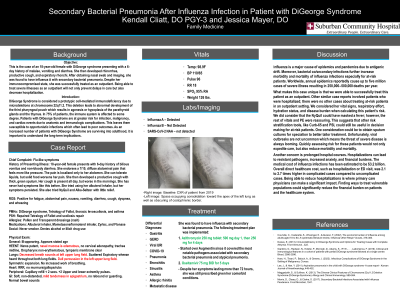Back

Clinical: Outcomes Studies
Secondary Bacterial Pneumonia After Influenza Infection in Patient with DiGeorge Syndrome
Friday, March 31, 2023
12:00 PM East Coast USA Time

- KC
Kendall Cliatt, DO (he/him/his)
Suburban Community Hospital
Philadelphia, Pennsylvania, United States
Presenting Author(s)
Introduction: This is the case of a young female with DiGeorge syndrome, repaired Tetralogy of Fallot, scoliosis repair, and asthma presenting with GI and respiratory symptoms. Her workup was significant for Influenza A virus, she had a productive cough and decreased breath sounds. Her chest x-ray demonstrated a consolidation in the left lung at the lateral aspect of the upper lobe. Literature has shown that influenza infection with co/secondary bacterial pneumonia greatly increases morbidity and mortality. DiGeorge Syndrome often leads to an immunocompromised status which can worsen disease outcomes. She was successfully treated as an outpatient, which has not been demonstrated in recent literature. Being able to treat severe illnesses as an outpatient will not only prevent delays in care but also decrease hospitalization.
Case Study: The patient is an 18-year-old female with past medical history of DiGeorge syndrome, repaired Tetralogy of Fallot, repaired scoliosis, and asthma. She initially presented with a 6-day history of malaise, vomiting and diarrhea. She then developed rhinorrhea, productive cough, and expiratory rhonchi. She had only taken Nyquil without relief. She had decreased breath sounds in the left upper lung field. Her asthma could have explained the rhonchi, but not her other symptoms. A covid and influenza swab confirmed an influenza A infection; now the concern was a potential secondary bacterial pneumonia. The acetaminophen in Nyquil could have masked a fever. A chest x-ray showed a consolidation in the left lung at the lateral aspect of the upper lobe. Since the patient was stable, she was treated as an outpatient. She was prescribed a 5-day course of azithromycin 250 mg twice on day 1 then once daily for the next 4 days. She was also given oseltamivir. Azithromycin was chosen over Augmentin since it covered the most notable pathogens associated with secondary bacterial pneumonia and atypical pneumonia. Oseltamivir was started given her comorbid conditions. She made a full recovery.
Discussion: This report is unique because there is little to no literature on treating high-risk patients with secondary bacterial pneumonia in an outpatient setting. Literature reviews of pneumonia in patients with DiGeorge were done in hospitals. One change that could have been considered was obtaining a sputum culture for speciation. This case showed that high risk patients, with mild to moderate symptoms, can be successfully treated as an outpatient. This can lower healthcare costs by decreasing hospitalizations and their potential complications.
Case Study: The patient is an 18-year-old female with past medical history of DiGeorge syndrome, repaired Tetralogy of Fallot, repaired scoliosis, and asthma. She initially presented with a 6-day history of malaise, vomiting and diarrhea. She then developed rhinorrhea, productive cough, and expiratory rhonchi. She had only taken Nyquil without relief. She had decreased breath sounds in the left upper lung field. Her asthma could have explained the rhonchi, but not her other symptoms. A covid and influenza swab confirmed an influenza A infection; now the concern was a potential secondary bacterial pneumonia. The acetaminophen in Nyquil could have masked a fever. A chest x-ray showed a consolidation in the left lung at the lateral aspect of the upper lobe. Since the patient was stable, she was treated as an outpatient. She was prescribed a 5-day course of azithromycin 250 mg twice on day 1 then once daily for the next 4 days. She was also given oseltamivir. Azithromycin was chosen over Augmentin since it covered the most notable pathogens associated with secondary bacterial pneumonia and atypical pneumonia. Oseltamivir was started given her comorbid conditions. She made a full recovery.
Discussion: This report is unique because there is little to no literature on treating high-risk patients with secondary bacterial pneumonia in an outpatient setting. Literature reviews of pneumonia in patients with DiGeorge were done in hospitals. One change that could have been considered was obtaining a sputum culture for speciation. This case showed that high risk patients, with mild to moderate symptoms, can be successfully treated as an outpatient. This can lower healthcare costs by decreasing hospitalizations and their potential complications.
